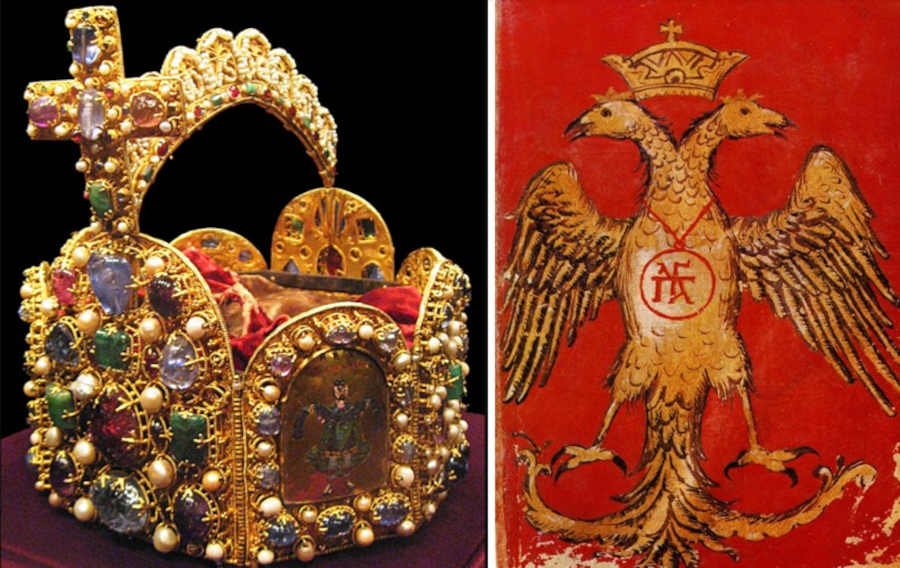The fall of Rome in 476 AD marked the end of an era, but not the end of its legacy. As the Western Roman Empire crumbled under pressure from Germanic invaders, the concept of “Rome” as the pinnacle of power and civilization endured. In the centuries that followed, various states and empires sought to claim the mantle of Roman succession, each believing they were the true heirs to the imperial legacy. From the Byzantine Empire in the East to the Holy Roman Empire in the West, and even to the far-reaching claims of the Russian tsars, the idea of Rome continued to shape European politics, culture, and identity long after the last emperor was deposed.
Roman Succession: The Quest for Imperial Legitimacy
Why Would States Claim Roman Succession? The temptation to claim Roman succession was a strong one. It came with plenty of benefits and few, if any, downsides. States and individual rulers sought this status for reasons that ranged from political and economic to cultural.
Legitimacy and Prestige: Attaching themselves to Rome’s impressive legacy was an excellent way for rulers to give themselves instant credibility and elevate their perceived status.
Divine Right: European kings relied on the idea of divine right to rule. Since Roman emperors had been seen as God’s choice, the idea of Roman succession appealed to monarchs looking to solidify their authority through religion.
Religious Authority: For Christian rulers, Roman succession did not just give them the right to rule their own countries. It lent the implied leadership of the entire Christian world.
Legal Precedent: Many aspects of Roman law outlive the Empire itself. Roman law was widely respected and continued to carry enough weight that rulers could use succession as a way of proving their right to rule.
Cultural Superiority: To many, Rome was regarded as the pinnacle of human civilization. By claiming to be its successor, monarchs could claim cultural and intellectual superiority over their challengers.
Territorial Claims: Succession was also a great tool for anyone looking to invasive lands once held by the Roman Empire. Expansion into former Roman territories wasn’t an invasion; it was simply taking back what was theirs.
Economic Benefits: Similarly, Roman succession could be used to “legitimately” lay claim to important trade routes. It also gave the right to mint universally accepted currency, which was associated with imperial status.
These benefits weren’t hypothetical or symbolic. They really worked. When Ivan III of Russia married the niece of the last Byzantine emperor in 1472, it instantly strengthened Moscow’s claim as the “Third Rome.” Similarly, Holy Roman Emperors constantly used their status to push around other European monarchs, as seen in the conflict between Emperor Henry IV and Pope Gregory VII during the Investiture Controversy of 1076-1122.

Ivan Fryazin showed to Ivan III the portrait of Sophia Palaiologina, by Viktor Muizhel. (Public Domain)
Major Claimants to Roman Succession:
Byzantine Empire
The Byzantine Empire, also known as the Eastern Roman Empire, is perhaps the most direct and legitimate successor to the Roman Empire. In fact, Roman succession was so integral to the Byzantine identity that it never actually referred to itself as the “Byzantine Empire.” Instead opting for titles like the Roman Empire, Empire of the Romans, or Romania. Outside its borders, many Western Europeans disliked using the word Roman while referring to the Byzantine Empire, whereas its Muslim neighbors often referred to its citizens as Romans.
Much of the Byzantine Empire’s claim of succession comes from the simple fact that following the fall of Rome in 476 AD, the eastern half of the empire continued to thrive for nearly a millennium, preserving Roman institutions, law, and culture.
The strength of the Byzantine’s claim to Roman succession lies in this direct continuity. The Byzantine Empire wasn’t some new entity pretending to be the Roman Empire; it was a direct continuation of (half) the Roman state.
One of the most significant aspects of the Byzantine claim was the preservation of Roman institutions. They kept the old Roman administrative structures, legal systems, and military organization untouched. The compilation of the Corpus Juris Civilis under Justinian I in the 6th century became a cornerstone of this continuity, later influencing many European legal systems.

Emperor Justinian is depicted in the center with a halo around his head in this mosaic from Ravenna, Italy. (Michleb/CC BY SA 3.0)
Culturally, the Byzantine Empire evolved but stayed close to its Roman roots. Greek replaced Latin as the primary language, but Latin was still used for official purposes until the 7th century. Byzantine emperors also used the old imperial titles, calling themselves things like Augustus and Imperator to make their claim to Roman succession clear.
However, the Byzantine claim wasn’t bulletproof. There was no ignoring the fact that Constantine had shifted the capital to Constantinople, far away from Rome. Over time, Byzantine control over Rome itself weakened, calling into question the empire’s connection to its Roman roots in Western eyes. Eventually the Byzantine Empire’s failure to control the former Western Roman lands caused many to question its claim to universal rule.
The Byzantine Empire also became less Roman over time. It developed distinct Greek and Christian characteristics that set it apart from the classical Roman model.
These weaknesses aside, the Byzantine Empire’s claim to Roman succession was regarded as the strongest and most widely recognized for a long time. Constantinople was a center of trade, culture, and Christianity and, in many ways, became the new Rome. When it fell to the Ottoman Turks in 1453, it was the end of the Roman imperial tradition that had survived for two millennia.
Holy Roman Empire/Carolingian Empire
Much like the Byzantine Empire didn’t refer to itself as such, neither did the Holy Roman Empire. Its citizens and rulers called themselves the Roman Empire, the Empire of the Romans, or most simply the Empire. Established in 800 AD with the coronation of Charlemagne I, the Carolingian Empire arguably had the second strongest claim to Roman succession. This claim lasted for over a millennium and only came to an end with the empire’s dissolution in 1806.
The Holy Roman Empire’s claim was rooted in a handful of key factors. Firstly, it had a certain degree of religious support. When Charlemagne was crowned by Pope Leo III in 800 AD, he was made the “Emperor of the Romans” by the pope. For the Christians of the West, this act transferred imperial authority from Rome to the Franks, which was then later transferred to the empire’s German rulers.

Pope Leo III crowning Charlemagne as Emperor. (Public Domain)
The Holy Roman Empire also adopted a “looking Roman=being Roman” approach. The empire used Roman symbols and titles that lent credence to its claim of continuity. Like the Byzantine emperors, the Carolingian rulers used titles like Augustus and Imperator. The concept of translatio imperii, or the transfer of imperial authority, was central to the empire’s ideology.
Then there was the Holy Roman Empire’s privileged relationship with the Catholic Church. The popes regarded the empire’s rulers as the protectors of Christendom. This papal endorsement of imperial authority went a long way in reinforcing the idea of a continuation of the Christian Roman Empire. Simply put, for most western European Christians, if the pope said it was true, it was true.
However, the Holy Roman Empire’s claims weren’t without flaws. Its decentralized nature, where power was divided between numerous princes and local rulers, was very different to the centralized authority of the real Roman Empire.
Geographically speaking, the empire also wasn’t that connected to the ancient Roman Empire. It was focused mainly on German-speaking lands and was limited to Central Europe. This undermined any claims to universal rule.
Many of its institutions weren’t that Roman either. For example, its imperial title was elective rather than hereditary. This was a sharp detour from the old Roman imperial traditions surrounding succession.
Over time, the empire’s claim only weakened. The Reformation in the 16th century was a major blow. How could the empire claim to be the continuation of the Christian Roman Empire when religious unity had been shattered? Later, the empire’s complete inability to resist threats like the Napoleonic conquests killed its plausibility when claiming to be a continuation of the greatest military power the world had ever seen.
The French writer Voltaire, a damning critic, put it best when he said the Holy Roman Empire was “neither holy, nor Roman, nor an empire.”
Ottoman Empire
Next up came the Ottoman Empire. They started claiming Roman succession after their conquest of Constantinople in 1453, which marked the end of the Byzantine Empire. Coming from a Muslim power rather than a Christian one, this claim marked a major departure from the traditional concept of Roman succession.
The Ottoman claim was centered around the principle of translatio imperii. Sultan Mehmed II believed that if the Byzantine emperors had truly been “Roman Emperors,” then by defeating him he acquired their right to that title too. After taking Constantinople, he declared himself “Kayser-i Rûm” (Caesar of Rome), emphasizing this claim.

Mehmed II of the Ottoman Empire, entering Constantinople. (Public Domain)
To back up their claim, the ottomans adopted many Byzantine institutions and practices, especially in administration and law (themselves continuations of Roman systems). They also preserved the Orthodox Patriarchate, allowing it to continue functioning under Ottoman rule. This continuation of Roman-Byzantine traditions lent some legitimacy to their claim of succession.
Geographically, the Ottoman Empire controlled much of the former Eastern Roman Empire’s territory, including significant parts of the Balkans, Anatolia, and the Middle East. This vast territorial extent bolstered their claim to be a universal empire in the Roman tradition.
Out of all the claims, the Ottomans were probably one of the weakest thanks to the multiple religious and cultural differences. As an Islamic empire, the Ottomans represented a clear break from the Christian Roman tradition. This made their claim difficult for European Christian powers to accept.
The Ottomans’ Turkish and Islamic cultural identity was also a problem. It was very different from the Greco-Roman culture that had defined the Byzantine Empire. While they did adopt some Roman-Byzantine traditions, they also made major changes. There was no denying the fact that Ottoman culture was different, and Europeans regarded it as foreign.
The Ottoman sultans could call themselves Caesar as much as they liked, but the Western European powers were not listening. To them, the Ottomans were usurpers, not legitimate successors to Rome. The Ottomans might have made the claim, but precious few outsiders took it seriously.
Russian Empire (Third Rome)
The final major claim to Roman succession came from Moscow in the late 15th century before gaining prominence in the 16th century. This claim, known as the concept of “Moscow as the Third Rome”, stood out because it was less about political and territorial continuity and focused on religious and cultural succession.
A large part of the Russian claims was centered around religion. Following Constantinople’s 1453 fall, Moscow made itself the last bastion of true orthodox Christianity. As the monk Philotheus of Pskov put it, “Two Romes have fallen, the third stands, and there will not be a fourth.”
The Russian empire also sought to bolster its claim via a strategic political marriage. The marriage of Ivan III to Sophia Palaeologus, niece of the last Byzantine emperor, in 1472 provided a dynastic link to the Byzantine imperial family. This connection was used to bolster Russia’s claim to be the heir of Byzantium and, by extension, Rome.
The empire also adopted many Byzantine symbols and ceremonies to strengthen its claim. The double-headed eagle, a symbol of Byzantine emperors, became the emblem of the Russian state. Russian rulers also adopted the title “Tsar,” derived from “Caesar,” further emphasizing their imperial aspirations.

The double-headed eagle, an emblem used by Byzantine emperors (1589) (Public Domain)
Just like those who had tried before it, the Russians’ claim had some major weaknesses. For a start, geographically speaking, Russia was far removed from the historic Roman territories. Russia held basically no old Roman lands, making its supposed connection to Rome tenuous.
The Russian Empire was also late to the party. Its delayed arrival as a serious European power meant other European states refused to even recognize its claim for several centuries. The concept of “Moscow as the Third Rome” was primarily an internal ideology rather than an internationally accepted status.
Its claim was also extremely limited in scope. The Russians decided to focus mainly on religious succession and chose to ignore the ideas of political and legal continuity. While this gave the claim a unique character, it also made it less directly comparable to the claims of entities like the Byzantine or Holy Roman Empires. It is hard to win any debate with a single argument.
Other Notable Claimants
While the Byzantine, Holy Roman, Ottoman, and Russian Empires were the most prominent claimants to Roman succession, they weren’t the only ones. Several other states also claimed to have connections to the Roman Legacy.
The Kingdom of Italy, following unification in the 19th century, based its claim on geographical and cultural grounds, encompassing Rome and much of the former Western Roman Empire’s core territory. This claim was particularly emphasized during the fascist era under Mussolini.
Greece, after gaining independence from the Ottoman Empire, asserted a connection to the Byzantine Empire and, by extension, to Rome, rooted in cultural and linguistic continuity. The “Megali Idea” envisioned restoring a Greek state centered on Constantinople.
French claims, while less direct, stemmed from Charlemagne’s coronation as Emperor of the Romans in 800 AD. Later French monarchs and Napoleon Bonaparte emphasized connections to Roman culture and adopted Roman symbols.
Conclusion
The idea of Roman succession has never really gone away. It extends beyond medieval power struggles and has profoundly shaped modern nationalism and geopolitics. These claims fueled the development of national identities, from Italian unification to Russian exceptionalism. Not always positive, political opponents of the EU will often draw comparisons to the European Union and Roman succession.
The idea of a shared Roman heritage contributed to the concept of European civilization, influencing everything from legal systems to architectural styles. While the practical significance of Roman succession has faded, its impact on national mythologies and international relations persists.
Top image: Imperial Crown of the Holy Roman Empire, late 10th / early 11th century. Right: Device of the Emperor John VIII Palaiologos, featuring the Byzantine double-headed eagle and the sympilema (the family cypher) of the Palaiologos dynasty. Byzantine miniature. Source: Public Domain, Public Domain
References
Barkey. K. 2008. Empire of Difference: The Ottomans in Comparative Perspective. Cambridge University Press
Freely. J. 2009. The Grand Turk: Sultan Mehmet II – Conqueror of Constantinople and Master of an Empire. Overlook Press
Editors. 2024. Ottoman Empire. Encyclopedia Britannica. Available at: https://www.britannica.com/place/Ottoman-Empire
Mansel. P. Constantinople: City of the World’s Desire, 1453-1924. John Murray Publishers






